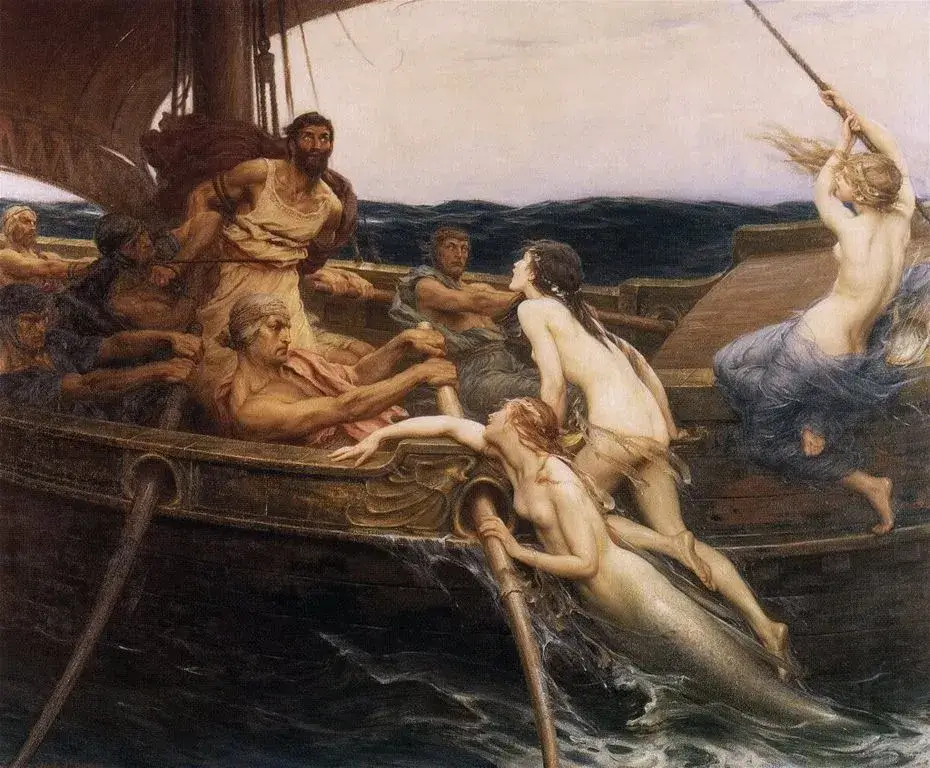In Greek mythology, the siren is a half-woman, half-bird creature that entices sailors to their demise with its enchanting song. Sirens are typically depicted as female, raising the question: Do male sirens exist?
What Exactly Are Sirens?
The Sirens, in Greek mythology, were mysterious creatures with the power to entice and ultimately doom sailors through their mesmerizing music and enchanting singing voices. These melodies had a bewitching quality that compelled sailors to steer their ships toward the Sirens’ island, where they met a tragic end, as their vessels crashed upon the treacherous rocky shores.

In the works of Roman poets, the Sirens were often depicted as dwelling on small islands known as Sirenum scopuli. According to Plato, there were three distinct types of Sirens: the celestial Sirens, associated with Zeus; the generative Sirens, linked to Poseidon; and the cathartic Sirens, connected to Hades. Each type likely symbolized various aspects of temptation and allure.
Throughout the medieval era, Sirens continued to serve as symbols of the dangerous allure and seductive nature often associated with women. Christian art frequently utilized Siren imagery to represent the temptation that could lead individuals astray from the path of righteousness.
Also Read: Story of Odysseus and The Cyclops: Tales From The Odyssey
Origins of the Male Sirens
The origin of the sirens in Greek mythology can be traced back to early descriptions in Homer’s Odyssey, where they made their first appearance, Homer did not provide a detailed physical description of the sirens, allowing readers to imagine their appearance. From the 3rd century BC, Apollonius of Rhodes provided a more concrete description of the sirens as creatures with both human and bird-like features in his work Argonautica.
Originally, sirens were depicted as either male or female. However, by the 7th century BC, Greek art began to portray sirens as beings with women’s heads and bird-like bodies. These depictions might have been influenced by the ba-bird found in Egyptian religious iconography. Early Greek art often depicted sirens as large birds with women’s heads, featuring bird feathers and scaly feet.
As time went on, the representations evolved to show sirens with human upper bodies and bird-like legs, sometimes with wings, commonly depicted playing musical instruments. The Byzantine dictionary Suda, dating back to the 10th century, described sirens as having the form of sparrows from their chests up, with the lower part being that of women or, in an alternative interpretation, as little birds with women’s faces.
Male Sirens in Greek Myth
Male sirens are not known as much as their female counterparts in Greek mythology. Unlike the seductive and alluring female sirens, male sirens were portrayed with bearded faces and possessed a unique allure that drew sailors not through temptation but with the promise of wisdom.
The male sirens, in their original stories, held equal prominence alongside the females, and they played a vital role within the context of Greek mythology. These male sirens served as guides, responsible for escorting the souls of the departed to the realm of the underworld.
Their purpose was not to lure sailors to their doom but to offer guidance and protection during the perilous journey from the world of the living to the afterlife.
When and How Did Male Sirens Disappear?
The disappearance of male sirens from Greek mythology and art is an intriguing evolution that can be attributed to several factors. While male sirens coexisted with their female counterparts in early Greek mythology, their gradual disappearance around the fifth century BCE can be understood through the following reasons:
- Cultural Shift: Over time, there was a cultural shift towards the portrayal of female figures as more alluring and seductive. This shift can be observed in various aspects of Greek art and literature, including the works of Homer and other poets.
- Homer’s Influence: Homer’s epic poem, The Odyssey, played a significant role in solidifying the image of the sirens as enchanting female creatures. In his narrative, the sirens are described as captivating maidens with enchanting voices. This portrayal became the standard representation of sirens in Greek mythology.
- Visual Appeal: The transformation of sirens into attractive female figures likely appealed more to the artistic sensibilities of the time. The image of beautiful women with musical talents was more visually enticing and relatable for artists and audiences alike.
- Narrative Role: As the sirens’ narrative role shifted from guiding souls to luring sailors to their doom, their portrayal as seductive females aligned more closely with their new function in stories.
In conclusion, the disappearance of male sirens and the shift towards the iconic, attractive female sirens can be attributed to changing cultural norms, the influence of epic poetry like the Odyssey, the desire for visual appeal, evolving narrative roles, and the natural evolution of artistic expression. This transformation is an example of how mythology and art adapt to reflect the values and preferences of their respective eras.
Are Male Sirens the Same as Tritons?
Tritons and sirens are not the same in Greek mythology. Tritons are sea deities with a human upper body and a fish-like lower body, associated with power and often serving Poseidon. In contrast, sirens are typically depicted as enchanting figures, renowned for their seductive voices and luring sailors to their doom. While both have connections to the sea, they have distinct roles and characteristics, making them separate entities in Greek mythology.
Also Read: 10 Strong Mythological Creatures From Greek Mythology You Need To Know
